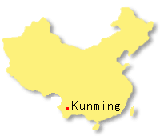Kunming Life
Kunming is the capital city of Yunnan province, China with a history of more than 2400 years. Kunming is renowned as the 'City of Eternal Spring' due to its year-round mild and pleasant spring-like climate. It has an estimated population of 3,740,000 including 1,055,000 in the urban area and is located at the northern edge of the large Lake Dian. It is also known as a city which plays host to the many Chinese minority ethnic groups with varying cultures which inhabit Yunnan. Around twenty-six ethnic groups can be found living in or around the city. The unique landscape of Kunming featuring attractions such as the Stone Forest and Dianchi Lake attract millions of visitors each year.
Archeological evidence appears to indicate that Kunming has been inhabited for approximately 2,000 years. Records can be traced back to 722 - 481 BC when the first Chinese began inhabiting the area. Following this time, the area surrounding present day Kunming has been witness to a succession of various kingdoms and dynasties. In the 20th Century, Kunming was targeted by the Imperial Japanese Air Force during their campaigns in China. The American Volunteer Group, also known as the Flying Tigers, flew out of Kunming in 1941 and 1942 in defiance of Japanese aggression. They also were tasked with defending China's lifeline to the outside world, the Burma Road, which had Kunming as its Northern terminus. One of the major developed cities in Southwest China, modern-day Kunming is thriving. Recently, it has seen the growth of its tourism industry and increasing foreign investment. The city is rapidly modernizing with more office and residential buildings being built everywhere.
Kunming is bordered by Dian Chi Lake on its south side, and mountains on every other side. Known as the "City of Eternal Spring", Kunming enjoys a moderate climate and fertile land, which earned it the honor of holding the annual International Horticulture Exposition.
Today the city is the political, economical and cultural center of Yunnan and the provincial center for transport, science and technology and consequently has become the most popular center for tourism in Southwest China. With its convenient transport links in and out of the city, Kunming welcomes and sees off tens of thousands of tourists every day. Kunming is also the focal point of many Chinese minority ethnic groups with varying cultures. Some 26 ethnic Chinese minorities such as Yi, Bai, Miao, Dai, Han and more inhabit the region. Each group has its own featured festivals such as the Torch Festival of Yi people, the Golden Temple Fair and so on. Kunming is a beautiful city rich in lakes, hills, stones, caves, springs, waterfalls, flowers, ancient trees, gardens, and well known for cultural relics and ethnic customs. It has become one of China's ten major tourist attractions. With beautiful scenery and all year round spring weather, Kunming offers tourists the ideal non-polluted environment for relaxation and enjoyment.
Kunming's economy was ranked 12th of all Chinese cities in 1992. The salt and phosphate mines around Kunming are some of China's best. Because of its location in a remote corner of China, Kunming was generally bypassed by China's rapid economic growth in the 1990s. However, recently the city has received renewed attention, launching Kunming into becoming an international hub that China desperately needs to access different areas of South and Southeast Asia. Several railroads and highways have been planned to connect Kunming to areas of Thailand, Vietnam, and Laos, providing Kunming access to sea ports. Kunming economic authorities are active participants in the Greater Mekong Sub-region, promoting trade throughout China, Cambodia, Laos, Myanmar, Thailand, and Vietnam. The city has 275 scientific research institutions employing 205,000 scientists and technicians. Included were 68,500 people with middle-level and senior professional titles. The contribution by scientific progress accounted for 32% of the city's economic growth, 36.6% of its industrial growth and 36.4% of its agricultural growth. The city is also spending more time to improve teaching conditions and raising the standard of education. |

 Kunming is one of the nation's 24 historic and cultural cities designated by the State Council in 1982. It was
built in 765 AD and originally called Tuodongcheng. It was named Kunming in the Yuan Dynasty (1271-1368) and has
since become the political, economic and cultural center of Yunnan Province.
Kunming is one of the nation's 24 historic and cultural cities designated by the State Council in 1982. It was
built in 765 AD and originally called Tuodongcheng. It was named Kunming in the Yuan Dynasty (1271-1368) and has
since become the political, economic and cultural center of Yunnan Province. Kunming is
situated atop a plateau in the central Yunnan Province. Kunming is at between
102 degrees and 103 degrees east longitude and between 24 degrees and 26 degrees
north latitude. With 140 kilometers from east to west and 220 kilometers from
south to north, Kunming covers 15,561 square kilometers and has a total population
of 3.749 million. Yunnan province borders Myanmar, Laos, and Vietnam on the
south and stands at an elevation of 1,891 meters above sea level. It enjoys
a protected location with mountains surrounding the city on three sides, and
a lake to the south.
Kunming is
situated atop a plateau in the central Yunnan Province. Kunming is at between
102 degrees and 103 degrees east longitude and between 24 degrees and 26 degrees
north latitude. With 140 kilometers from east to west and 220 kilometers from
south to north, Kunming covers 15,561 square kilometers and has a total population
of 3.749 million. Yunnan province borders Myanmar, Laos, and Vietnam on the
south and stands at an elevation of 1,891 meters above sea level. It enjoys
a protected location with mountains surrounding the city on three sides, and
a lake to the south. Kunming owes its importance
to the fact that it was the gateway to the celebrated Silk Road that facilitated trade with Tibet, Sichuan, Myanmar and India.
Kunming owes its importance
to the fact that it was the gateway to the celebrated Silk Road that facilitated trade with Tibet, Sichuan, Myanmar and India. 
